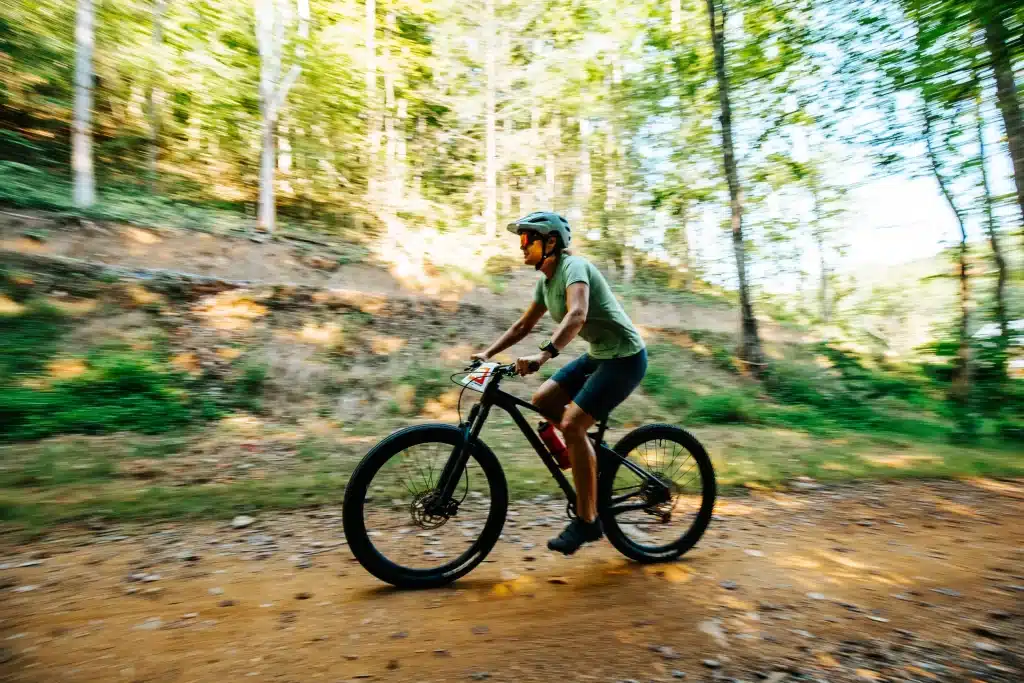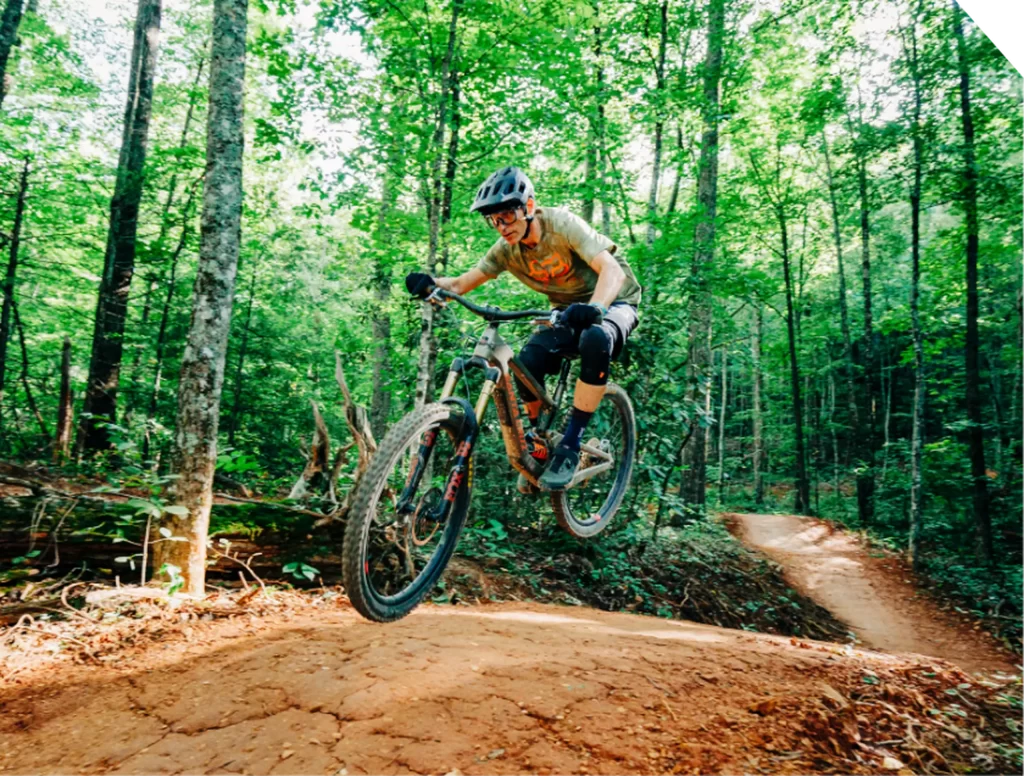If you’re looking for a fun way to work out while spending time in nature, mountain biking is one of the best activities you can do. As an exceptional lower body workout that also works your core and parts of your upper body, mountain biking offers an exhilarating way to explore the outdoors while building strength and burning calories.
Key Takeaways
- Lower body: Mountain biking targets your quads, hamstrings, calves, glutes, hip flexors, and shins through each phase of the pedal stroke.
- Core & upper body: Your abs, shoulders, back, and arms work together to keep you balanced, control the bike, and absorb bumps on the trail.
- Calories burned: Depending on terrain and effort, you can burn anywhere from 200 to 1,400 calories per hour, making it an effective cardio workout.
- Try WildSide: Explore 11+ miles of trails, rent a bike, or hit the jump park in Pigeon Forge, TN—options available for every skill level.
What Muscles Does Mountain Biking Work?
Mountain biking targets a number of muscles, including those in your calves, hamstrings, quads, glutes, shoulders, chest, forearms, and arms. Even if you’re new to mountain biking and cycling on easier trails, the pedaling and terrain will give your body a workout. If you’re interested in adding biking to your workout routine, learn more about the muscles mountain biking targets below:
Lower Body Muscles Targeted by Mountain Biking
Before we discuss which muscles bike riding targets, it’s important to understand that mountain biking engages your lower body muscles through two different, distinct phases of the pedal cycle—the power cycle and the recovery cycle. In the power phase, your muscles generate the force required to move the bike forward, and in the recovery phase, your muscles are less active.
Within these two phases, your muscles will also be activated at different points in the 360° circle your pedals follow. For example, if you’re at the top of your pedal cycle, your feet and pedals are at the 0° mark, and you’ll be activating different muscles than you will at the opposite 180° position. Additionally, the power phase primarily takes place between the 0° and 180° positions (12 o’clock to 6 o’clock), while the recovery phase takes place between the 180° and 360° positions (6 o’clock to 12 o’clock).
Review our breakdown of the primary lower body muscles exercised by cycling at different stages of the pedal cycle below:
-
Quads
The vastus lateralis, vastus medialis, and rectus femoris are the key quad muscles active during mountain biking. These muscles are primarily engaged during the power phase, spanning roughly 315° to 105°, driving the knee downward.
The rectus femoris also re-engages around 180° at the beginning of the recovery phase to assist with hip flexion, making it active in both phases of the pedal cycle. -
Hamstrings
From 45° to 125°, the hamstrings work alongside the glutes to support hip extension. Near the end of the power phase, the hamstring group (especially the biceps femoris) plays a key role from 135° to 180°, helping to lift the leg.
-
Calves
The soleus and gastrocnemius muscles in a biker’s calves support the ankle and foot through much of the stroke. The soleus contributes from 30° to 145° during the power phase, while the gastrocnemius spans from 35° to 260°, bridging both the downward and upward movements of pedaling during the power and recovery phases.
-
Gluteus Maximus
The glutes are heavily activated from 0° to 45°, initiating forceful hip extension at the start of the power phase. They continue to work through 45° to 125° alongside the hamstrings, making them central to momentum generation during the entire power phase.
-
Iliopsoas
The iliopsoas, a powerful hip flexor, is primarily engaged during the recovery phase of the pedal cycle, from about 180° to 360°. Its main function is to lift the thigh and initiate the upward movement of the leg after the power stroke. This muscle becomes especially active during high-effort riding, such as climbing or sprinting, when quick leg turnover is required.
-
Shin Muscles
The tibialis anterior, located along the front of the shin, helps lift the foot by dorsiflexing the ankle during the upward stroke of the pedal cycle. It is active from around 270° to 90°, covering the late recovery and early power phases.
This muscle smooths the pedal transition over the top of the stroke and aids in efficient energy transfer through the pedal rotation.

Core Muscles Targeted by Mountain Biking
While mountain biking primarily works the lower body, it can also give your core a bit of a workout. Essentially, your abdominal muscles help your body stay balanced while you’re climbing uphill or flying downhill. Since mountain biking engages the core, your abdominal muscles will get stronger the more you mountain bike.
Upper Body Muscles Targeted by Mountain Biking
Unlike road cycling, mountain biking demands constant full-body engagement due to uneven terrain, rapid changes in elevation, and technical features like rocks, roots, and descents. Upper body muscles are especially important for stability, bike control, shock absorption, and handling during climbs and descents.
These muscles work hardest when riders are out of the saddle, navigating steep trails, or absorbing vibrations from rough terrain. If you plan to ride on advanced trails, expect some soreness in your upper body the next day!
Check out the following upper body muscles you’ll work while mountain biking:
-
Rotator Cuff Muscles
Your rotator cuff muscles support shoulder movement and joint stability, particularly while absorbing impact on rugged trails or pulling the handlebars during steep climbs.
-
Deltoids
Your delts assist in lifting and lowering the arms, particularly during standing climbs and sharp descents where active shoulder motion and shock absorption are critical.
-
Trapezius
When you’re bracing through tight turns or climbing out of the saddle, the trapezius helps lift and stabilize the shoulders.
-
Latissimus Dorsi
Your lats contribute to balance and upper body coordination, especially when shifting weight to maneuver around obstacles.
-
Triceps
When you’re descending, your triceps control arm extension and provide essential support, helping absorb impact forces and maintain upper body stability.
-
Biceps Brachii
During climbing and technical riding, your biceps brachii help you maintain your posture and assist with lifting or pulling on the handlebars.
-
Forearms
Your forearms (especially the brachioradialis) are critical for grip strength, braking, and shifting. They’re particularly important during fast descents and technical terrain where hand control is non-negotiable.
-
Serratus Anterior
While working with the pectorals, your serratus anterior stabilizes the shoulder blades, supporting forward arm motion and absorbing trail vibrations.
-
Pectoral Muscles
Your pecs help control shoulder movement and enhance upper body stability, especially while descending or riding in a standing position to absorb shock.
How Many Calories Does Mountain Biking Burn?
According to Harvard University, a 125-pound person will burn 255 calories, a 155-pound person will burn 316 calories, and a 185-pound person will burn 377 calories while mountain biking on average. Others estimate that mountain biking will burn between 200 and 1400 calories every hour.
That said, the amount of calories you burn while mountain biking depends on a variety of factors, such as the length, surface terrain, rolling resistance, and intensity of the ride. Other factors that can affect your caloric expenditure while mountain biking include your weight, the size of wheels your bike uses (26-inch wheels burn more calories than 29-inch wheels!), tread pattern, bike mass, tire pressure, biking posture, gradients, and the amount of wind.
Since mountain biking covers a wide variety of terrain and a rider’s body composition/bike can impact caloric expenditure, accurately estimating the amount of calories you’ll burn is fairly difficult. However, mountain biking does provide a good workout, and you can generally expect to burn at least a few hundred calories on hour-long rides.

Frequently Asked Questions About Mountain Biking and Fitness
Mountain Bike in the Smoky Mountains at Wildside
If you’re looking for mountain biking trails or rentals in Pigeon Forge, TN, Wildside has you covered. At our adventure park, we offer a wide selection of manual and electric bikes for rent, 11+ miles of mountain biking trails, and a jump park. Whether you’re just beginning to mountain bike or want a more challenging course to test your skills, you can find multiple trails perfect for your skill level at Wildside.
Learn more about our mountain biking trails and jump park today.